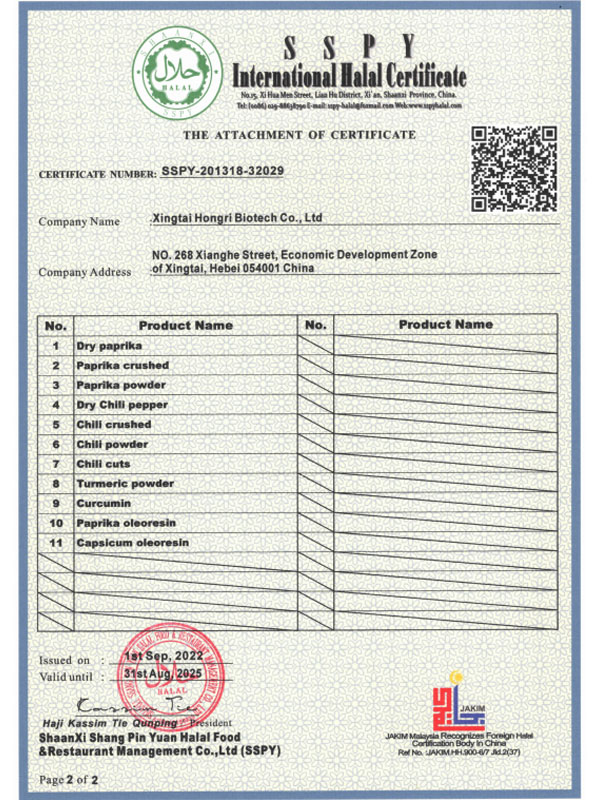- No. 268 Xianghe Street, Economic Development Zone of Xingtai city, Hebei 054001 China
- Byron@hbhongri.cn
the spice paprika
The Spice Paprika A Journey Through Flavor and History
Paprika, a vibrant and versatile spice, is a staple in many kitchens across the globe. Its bright red hue and distinct flavor profile have established it as a beloved ingredient in numerous culinary traditions. Originating from the Capsicum annuum species of pepper, paprika is made from grinding dried sweet or spicy peppers. This article explores the nuances of paprika, its culinary applications, health benefits, and cultural significance.
A Brief History
The history of paprika is fascinating and interwoven with the agricultural practices of various cultures. While the pepper plant is native to the Americas, it was brought to Europe in the 16th century by Spanish explorers. Hungary emerged as a key player in paprika production, developing its own unique varieties and elevating it to a cultural emblem. Hungarian chefs mastered the art of cultivating and processing peppers, resulting in the rich and flavorful paprika that defines Hungarian cuisine today.
In Hungary, paprika is more than just a spice; it is a symbol of national pride. The country's iconic dishes, such as goulash and chicken paprikash, are incomplete without this essential ingredient. Over the years, the spice became so popular that it was adopted in various forms around the world, each adapting it to different culinary needs.
Types of Paprika
Paprika can be categorized into several types based on its flavor, color, and heat level. The most common varieties include
1. Sweet Paprika Mild and slightly sweet, this version is often used to impart color and subtle flavor to dishes. 2. Hot Paprika For those who enjoy a kick, hot paprika is made from spicier varieties of peppers, adding a fiery touch to recipes. 3. Smoked Paprika Also known as pimentón, this variant is made from peppers that are smoked before drying, resulting in a deep, smoky flavor. It is a key ingredient in Spanish dishes like chorizo and paella. 4. Hungarian Paprika Available in several grades, from delicate sweet to intensely hot, Hungarian paprika is celebrated for its depth and complexity.
Each type not only enhances the visual appeal of dishes with its vibrant color but also contributes unique flavor nuances that can elevate an ordinary meal to something extraordinary.
the spice paprika

Culinary Uses
Paprika is remarkably versatile, finding its way into a multitude of dishes across different cuisines. One of its most well-known applications is in stews and soups, where it adds both flavor and a rich red color. It is also a popular seasoning for meats, poultry, and fish, imparting depth and warmth to rubs and marinades. In addition, paprika can be sprinkled over vegetables to enhance their flavor profile without overwhelming them.
Moreover, it plays a significant role in creating spice blends. For instance, it is a key component of the famous spice mix known as ras el hanout, commonly used in North African cuisine. Paprika also lends itself well to vegetarian dishes, enhancing grains, legumes, and roasted vegetables with its warm flavor.
Health Benefits
Beyond its culinary prowess, paprika boasts several health benefits. Rich in antioxidants, particularly carotenoids, paprika contributes to boosting overall health. These antioxidants help combat inflammation and are linked to improved vision and skin health. Additionally, paprika contains vitamins A, E, and B6, as well as essential minerals like iron and magnesium.
Furthermore, paprikas’ potential anti-inflammatory properties may aid in digestion and improve cardiovascular health. This makes it not only a flavor enhancer but also a nutritious addition to a balanced diet.
Conclusion
In conclusion, paprika is more than just a spice; it is a vibrant testament to culinary heritage, versatility, and health benefits. Its rich history, combined with its ability to enhance flavors and colors in dishes, makes paprika a cherished ingredient in kitchens worldwide. Whether you're sprinkling it on roasted potatoes, stirring it into a hearty stew, or using it as a rub for grilled meats, paprika brings warmth and depth to any culinary creation. From the sun-drenched fields of Hungary to kitchens around the globe, paprika continues to inspire a passion for cooking and gastronomy. So next time you reach for this vibrant spice, remember the journey it has taken to become a beloved staple in your culinary adventures.







